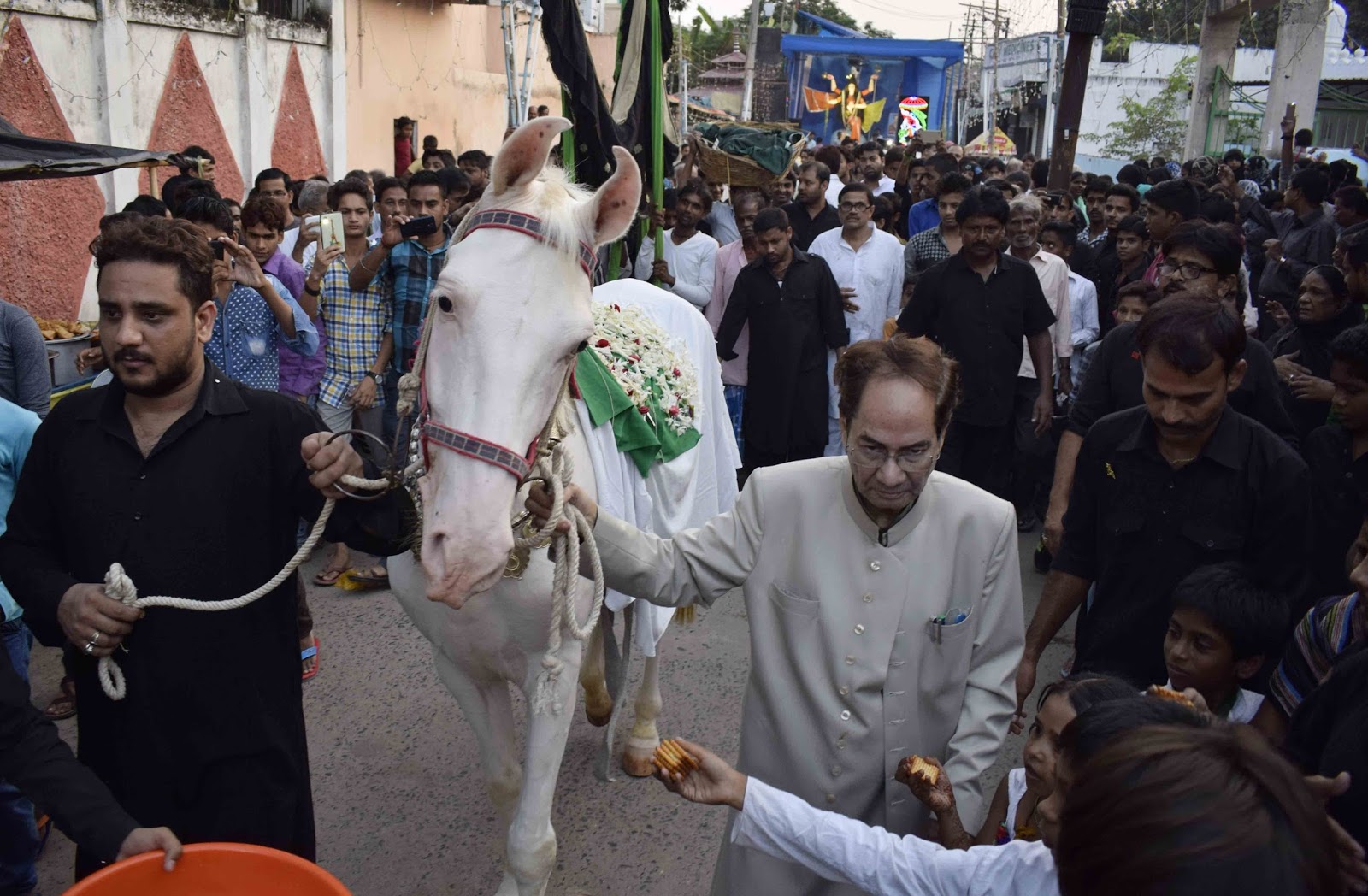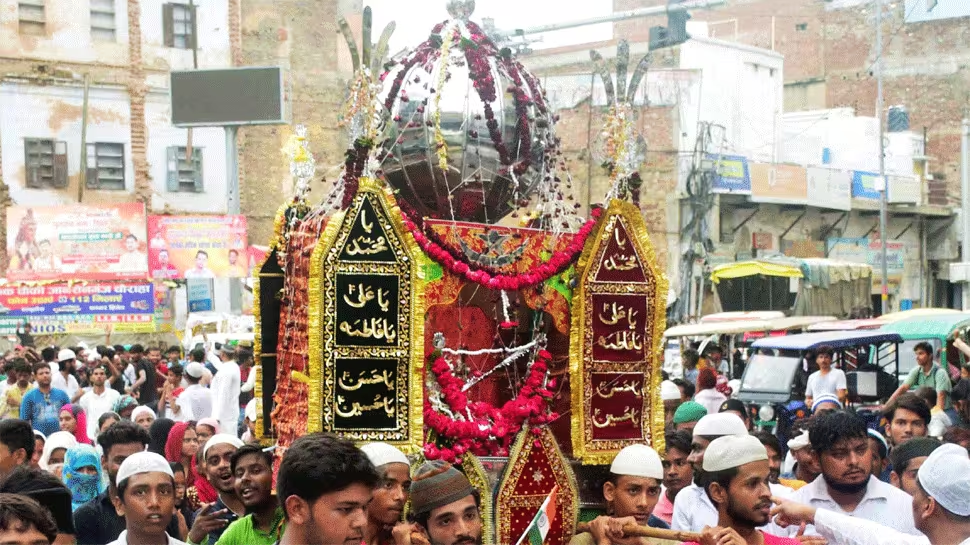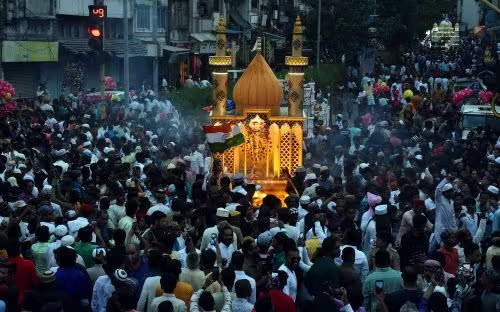
Firdous Khan
The world over theShia Muslims commemorate the martyrdom of Prophet Mohammad's grandsons Imam Hasan and Imam Hussain at Karbala during the month of Muharram, which also marks the beginning of the new (lunar) year in Islam.
The Indian Shia population is estimated to be around 10-15 percent of the Muslim population yet it’s a vibrant community that follows its customs and traditions with a tinge of Indianness. The Muharram, during which Shia wear black -oloured clothes and take out ritualistic mourning processions across many cities, towns and villages.
The flags used during the procession are called Alum. It is made in memory of the flag of Imam Hussain's army in Karbala. The flag has a claw-type mark on it which is called Panjtan Pak and it metaphorically represents Prophet Mohammad, Ali, Fatima, Imam Hasan and Imam Hussain.
 The horse taken out ceremoniously in the Muharram procession
The horse taken out ceremoniously in the Muharram processionAlums are normally made from bamboo. Many alums displayed during the Muharram procession are large enough and are carried by a group of persons while others are small enough to be easily grasped by a single person. People holding big lamps lead the procession. There is also a horse in the procession.
The name of the horse of Imam Hussain was Zuljanah. A very good horse is selected for the procession. The horse is decorated and a headdress is placed on its back. Since it is considered to be the horse of Hazrat Imam Hussain, it is very well taken care of. It's fed milk and jalebi. No one is allowed to ride on it during Muharram.
There are also turbats in the procession. Turbat meaning grave is made in memory of the martyrs of Karbala. Two turbats are kept in Tazia. One turbat in memory of Imam Hasan is green in colour to depict his death caused by poisoning.
Imam Hussain's turbat or grave is of red colour, because he was martyred in the state of prostration and his body became red with blood. The procession also displays a gahwara (cradle). This is in memory of the martyrdom of Ali Asghar, the six-month-old son of Imam Hussain, who was killed by an arrow.
 A Taziya during a Muharram procession
A Taziya during a Muharram procession
A pot containing Mehendi (Henna) and placed on a chowki (low lying table) is also carried in the procession of Muharram. It is said that Imam Hasan's son Qasim had got married a day before the battle of Karbala. Mehendi symbolises the festivities of wedding. It seems Abbas had gone to fetch water for Sukaina, daughter of Imam Hussain, when he was martyred. In memory of this a mashq (animal skin pouch to carry water) is also an element of the procession.
Besides, the procession also has Ammari, which is a guarded ride that was used by women in Arab while travelling those days. It is taken out ceremoniously in the procession on the 8th of Muharram in memory of the women who were present at the Battle of Karbala.
People cry seeing these displays as it is supposed to recreatre the scene of karbala to them. Marsiyya and Nauhe (songs of mourning) are read. During this people mourn by thumping their chests. Many people get injured as they hit themselves with iron chains and swords while reciting, 'Ya Hussain, Ya Hussain'.
In many places people walk on hot coals. The special thing is that their feet do not get scorched in the fire. They walk as if they are walking on bare floor. Some people also offer namaz by spreading musalla (Mat) on the burning coals. It is believed that the mat remain intact and is not damnaged by the cinders. People apply the soil of Karbala on their self-inflicted wounds and are cured. The suffering is to feel the pain inflicted upon Imam Husain and Imam Hasan and their families at Karbala.

Devotees beting themselves with chains during the Muharram procession
Tazia, symbolising Imam Hussain in fasting, is taken out on the 10th of Muharram. It's made of wood, mica and coloured paper. It can be of any size and artisans make it according to their own imagination. Each taziya has a dome.
India has a tradition of remembering its dead since ancient times. Among Hindus, Shradha is one such ritual, through which reverence and gratitude are expressed towards the ancestors. It is believed that the current generation owes debts to their ancestors as they are because of them. That's why on the days of Shraddha, people do charity in the name of their ancestors and also keep a fast to show their gratitude to them.
As Hindus don't slot any aspicious function like wedding, party, etc. during Sharadha, Shia and other Muslims who have immense love for Imam Hussain also do not do anything that is source of happiness from Muharram to Chehlum. People don't even buy new clothes, jewelry and other such things for 10 days of Muharram.
The tradition of taking out processions of deities in India has been going on since ancient times. The chariot festivals of Jagannath Puri of Odisha is world famous. Similarly, a procession of Goddess Durga is taken out on Vijaydashami during the Dugra Puja festival and of Lord Ganesh on Ganesh Chaturthi. Krishna's Shobha Yatra is taken out on Janmashtami and Shiva's Shobha Yatra is taken out on Shivratri.
The difference is that the Muharram procession is taken out in sorrow and Shobha Yatras are taken out in the spirit of joy. On Muharram, the taziya are buried, while the idols of Goddess Durga and Ganesha are immersed in water.

A grand taziya being taken out on Muharram
Hindus also participate in the Muharram procession. Tabarukh, (consecrated food) which is distributed in Muharram, is also accepted by Hindus with great reverence. Tahira of Shikarpur in Uttar Pradesh says that Hindu women always want Tabarukh.
When asked what she does with it, Tahira said that she keeps the rice of Tabarukh dry. When any of her children falls ill, she feeds a few grains of rice to him. This cures the child.
ALSO READ: Manipur imbroglio: Kuki-Meitei divide must be bridged at the earliest
The devotion of Indians of all faiths is unique. This is the country, where the earth is called as mother earth since it nurtures us. Giving respect to each other's religion and customs is our specialty and this is Ganga-Jamuni Tehzeeb.
Firdous Khan is the author of Faham Al-Quran
